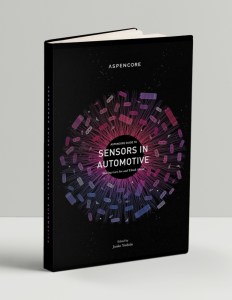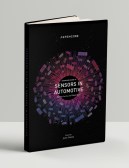 AspenCore Media has published its first book, “AspenCore Guide to Sensors in Automotive: Making Cars See and Think Ahead,” and the title says it all. This is a comprehensive look at the growing number of sensors – radar, LiDAR, MEMS, ultrasonic, imagers, etc. – being designed into next-generation vehicles. These sensors are helping OEMs bring new and safer technologies like advanced driver assistance systems (ADAS), driver monitoring systems (DMS) automatic emergency braking (AEB), and precision navigation, while helping to transform the automotive industry with connected cars and autonomous vehicles (AVs).
AspenCore Media has published its first book, “AspenCore Guide to Sensors in Automotive: Making Cars See and Think Ahead,” and the title says it all. This is a comprehensive look at the growing number of sensors – radar, LiDAR, MEMS, ultrasonic, imagers, etc. – being designed into next-generation vehicles. These sensors are helping OEMs bring new and safer technologies like advanced driver assistance systems (ADAS), driver monitoring systems (DMS) automatic emergency braking (AEB), and precision navigation, while helping to transform the automotive industry with connected cars and autonomous vehicles (AVs).
Edited by Junko Yoshida, AspenCore’s global editor-in-chief, the 152-page anthology includes chapters from leading automotive OEMs, component suppliers, industry analysts, and thought leaders, as well as editors across AspenCore Media, publisher of publications including EE Times, EDN, Electronic Products, Power Electronics News, and EPS News.
“Making cars see and think ahead is no trivial task. It requires advanced hardware — better sensors and more powerful computational processors — and those elements are certainly in high demand,” said Yoshida. “But perhaps even more critical is a rigorously engineered software and system architecture in which all the building blocks fit together and work effectively and harmoniously inside an advanced driver assistance system (ADAS) or autonomous vehicle (AV).”
This is what the book is all about, sharing industry insights and knowledge from automotive leaders across the supply chain about what it will take to make future ADAS and AVs safer and more reliable.
The book opens with a forward by Michiel van Ratingen, Secretary General, Euro NCAP, who has been at the forefront of vehicle safety developments for several years. He said: “Identifying the key players in the industry and clarifying the market potential and limitations of the next generation of sensor technology allow the reader to catch a glimpse of the future of automotive safety and AVs and to understand the most important challenges that we will need to overcome.”
Other contributors include: safety expert Phil Koopman, co-founder and CTO at Edge Case Research and associate professor, Carnegie Mellon University; Phil Magney, co-founder of VSI Labs; Colin Barnden, lead analyst at Semicast Research; Mike Demler, senior analyst at The Linley Group; Mark Fitzgerald, associate director for automotive at Strategy Analytics; Egil Juliussen, former director research at IHS Automotive, and Rob Stead, conference director of AutoSens.
One chapter looks at Waymo’s AV technologies, who is considered a leader in AV software and sensors, and why it is using so many cameras along with Google’s advanced AI capabilities for its camera-based system. Also addressed in the book are a myriad of challenges – and some yet to be solved – that range from object sensing in AVs and AV sensor fusion to the evolving vehicle architecture to address the “hodgepodge of various electronic control units (ECUs)” thanks to ECUs being added for every new function or feature, precision mapping, autopilot systems, and sensor degradation, a critical topic not often covered.
Along with technology analysis, the book features one-on-one interviews with Amnon Shashua, CEO of Mobileye, an Intel company on “The Chasm Between ADAS and AV” and Peter Hartwell, CTO of TDK InvenSense on “Augmenting Human Sensors in a car.”
There also is a chapter devoted to the state of sensors in the automotive market based on market research reports and analysts’ observations at Yole Développement. Yole covers every facet of the auto industry and warns the industry about “blurring the differences among ADAS, autopilot, and AVs” for very specific reasons.
The book compiles all of AspenCore’s news and technology coverage on sensors in automotive, making it easy to find in one location. The book also includes a reference section with tech papers from Intel, Nvidia, Siemens, NXP, Arm, OmniVision, and Qualcomm.
On the road to truly connected cars and AVs, a lot of sensor technology development as well as debate about the use of radars, LiDARs, camera systems, in-vehicle connectivity, and ECUs, is happening every day, and this book provides insights into those developments today and into the future.

A new book, AspenCore Guide to Sensors in Automotive: Making Cars See and Think Ahead, with contributions from leading thinkers in the safety and automotive industries, heralds the industry’s progress and identifies the engineering community’s remaining challenges.
It’s available now at the EE Times bookstore.
Advertisement





